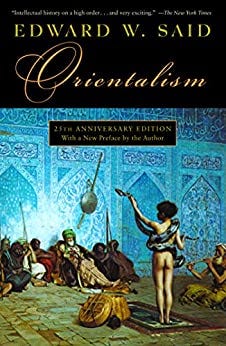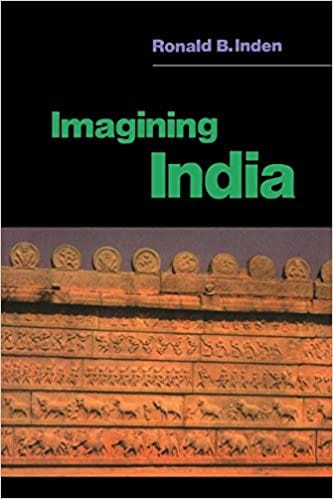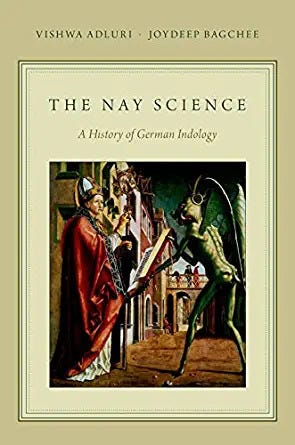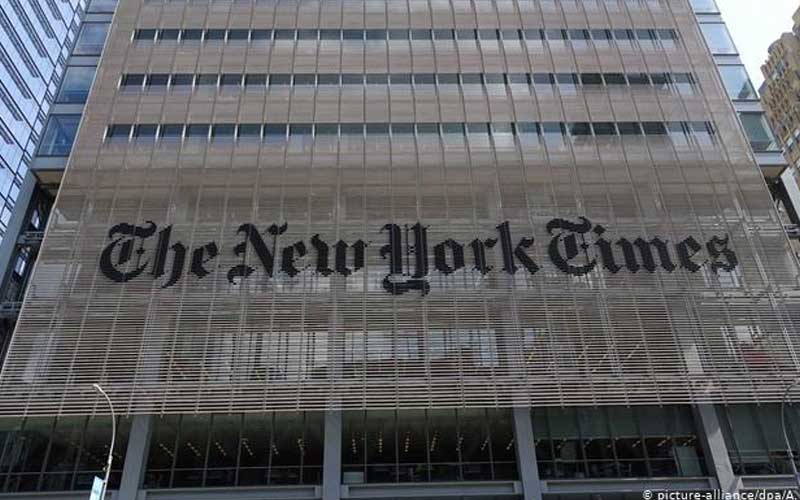Understanding The New York Times’ Anti-Hindu Bias
The enormous leverage that a newspaper like The New York Times has and how the agenda they have set for India is found by many to be “monstrous, false, and debased” needs to be stressed.
In the first three articles here, here, and here on The New York Times’ anti-Hindu bias I have offered a variety of examples to showcase that bias: the egregious and provocative headlines, the sustained series of reports, editorials, and commentaries that are completely, overwhelmingly partisan and anti-Hindu and anti-Bharatiya Janata Party (BJP), and the soft-pedalling of if not the complete absence of reports and commentaries critical of any other religious group or political party in India, making it obvious that the NYT is keen on changing the social/cultural/political dynamic of India, and does not consider it interference in another country’s internal affairs, and worse yet, seeking to impose its set of values and its agenda on a predominantly Hindu society that has borne the brunt of attacks from Islam-inspired and colonial/Christian forces over the past 1,500 years.
The question now is whether we do really need a theory or some theories to explain and understand this anti-Hindu bias of the NYT? In this particular instance, when we are looking at a series of systematic and totalizing anti-Hindu, anti-Hinduism articles, biased reporting and commentary in a prestigious newspaper, can we not merely list the articles, name the authors, point out the lies, the subterfuge, the exaggerations, the cherry-picking of facts, and point out where and how the bias is evident and leave it at that? Is it important to theorize the nature, the intent, the goals, and the reasons for such bias?
Some have argued that we should do away with theory, especially literary theory, because the attempts at objectivity and validity claims in literary interpretation are fools’ errands. Having just bought and read “The Rose and the Lotus: Partnership Studies in the Works of Raja Rao,” and considered the obtuseness, pretentiousness, and the vagueness of Stefano Mercanti’s project to “frame” Raja Rao’s work and understand Raja Rao as an author who was shaped by India and the West, and the vast numbers of students around the world engaged in projects of “deconstructing” this or that text, or this or that author, we can very well let those with obsessive personality disorders pursue their pastime — literary theory.
Similarly, we can find weaknesses in economic, political, psychological, or sociological theories: when it comes to social scientists wanting to imitate those working in the hard sciences we can wonder why so many people are engaged in proposing their shaky and unreliable theories and how their eager-beaver students embrace these “constructions” to “deconstruct” — letting the theory tails wag the data dogs.
Theories are, we tell our social science students (I teach communication courses), basically systematic hunches about why human beings do this or that or how social and political organizations can achieve this or something else. We point out that theories can be considered as nets, lenses, and maps to capture, explore, or describe human behavior. Friend Koenraad Elst, author of many books on Indian politics, society, and linguistics has told me that he eschews theory, though he uses evidence to reject or challenge some theories, like the Aryan Invasion Theory (AIT) or the Aryan Migration Theory (AMT) and why the Out of India (OIT) Theory is more plausible than the popular AIT and the AMT.
So, when it comes to understanding The New York Times’ coverage of Indian and Hindu matters and what specifically drives the anti-Hindu narratives, theorizing could help us somewhat to discover and map the fault lines; understand the nature of the lies, the exaggerations, the prevarication, and the cherry-picking; zoom in on images, headlines, and authorial ideologies; and weave nets to sift reportorial bias from verifiable facts.
In the three previous articles in this series I have already referred to the works of Edward Said (1978/1981), Ronald Inden (1990/2000), and S. N. Balagangadhara (1994/2012), and how we can use “orientalism” as a framework for studying elite Western media’s coverage of Indian matters. When we are led to believe that what the Western media offers is “truth” — that describes reality/events precisely, rationally, logically, scientifically, and objectively — we can wear our solar topees and carry our theoretical toolboxes to find out if the Western reporters/commentators/or their hired local hands have any better knowledge of Indians, Hindus, Hinduism than what Indians/Hindus themselves know about themselves, their history, their values, and their aspirations, and what kinds of sleights of hand are used to paint Indian reality. These theoretical frameworks can allow us to go beyond mere consideration of the quantitative news-flow discrepancies and types of news coverage and figure out what else might be at play in the descriptions, analyses, characterization, and labeling of others.
Edward Said’s work has been very influential in American and European acadme, and in fact may have led to the hiring of Muslim opinion editors at The New York Times and other Western media to make up for old habits, and who now use their Muslim clout to find Hindu targets (Basharat Peer, an Indian-Kashmiri Muslim is the Opinion Page Editor at The New York Times who has flooded the op-ed pages with an unrelenting series of anti-Hindu, anti-India opinion pieces). Said has been criticized for ignoring the totalitarian, fascistic, and authoritarian regimes in the Middle East, headed by Muslims, because he found it convenient to target Israel and the West for all the ill that has shaped and continues to shape and influence the region (Nick Cohen, 2007). The orientalist critique has been embraced by a large group of scholars who have used it both as a cudgel and a mask. As Elst (2013) points out, Said’s “…strongly pro-Muslim sympathy, which took the form of culpabilizing any scholarly critique of Islam as a Western imperialist project, was due to the Christians’ centuries of living as Dhimmis (‘charter people’, protected ones), used to bending before and singing the praises of Islam. Said’s defence of Islam, over 90% of his book and the topic of several other publications of his, together with his sowing of suspicion against Western scholarship, were exactly what trendy Western and westernized intellectuals needed, and what the Islamic world has gainfully instrumentalized since”.

Balangangadhara (2012) therefore rejects that his work follows in the footsteps of Edward Said though he acknowledges that the way the West has characterized the East is racist, imperialist, and sexist.
Balagangadhara’s (1994) work explores more fully the conceptualization of religion in the West, and how such conceptualization shaped the West’s characterization of Hindu/Indian traditions, beliefs, and behaviors. Balagangadhara (2012) then builds on his initial work to argue that colonial consciousness pervades not just colonial scholarship and commentary on India but also modern descriptions of India. We can therefore argue that the descriptions and characterization of Hindus and Hinduism and of the BJP in The New York Times are selective, and these colonial ways of describing India/Hindus persist to this day. Balagangadhara traces this back to the Christian theological understanding of “heathen religions”. He argues that the current social sciences sustain orientalism because they assume that what the West/social scientists experience of the other is “veridical, authentic, scrupulous, and scientific”. Such training changes the way Indians themselves have begun to look at their experiences. What we fail to understand is that this “modern/Western/colonial” enterprise is built upon 1500 years of Christian theological constructions/beliefs and the varieties of secularized projects that it has incubated and influenced in higher education and in turn the media.
The discourse of “orientalism” (Said, 1978/1981), to an extent, can help us understand the New York Times’ representations of the Indian government, Hindus, and “Hindu nationalism”. In this instance, the reference to “Hindu nationalism” is never in the context of other nationalisms, identities, and aspirations: for example, the reader is not told what other nationalisms — Muslim nationalism, Christian nationalism, secular nationalism, Gandhian nationalism, or whatever other applicable such “nationalisms” — are at play in the Indian context and why or how “Hindu nationalism” is problematic/debilitating and other nationalisms are correct, acceptable, good. “Nationalist” was a God-term for a long while, and statesmen and wise women swore that they were nationalists. Durga Das (1970) in his opus “India from Curzon to Nehru and After” writes that Mohammed Ali Jinnah, the Muslim politician, now called the “Father of Pakistan” once said, “I have been a nationalist. I am a nationalist. And I will always be a nationalist,” when challenged about his commitment to India’s independence struggle. It is only now that political activists, cultural warriors, academics and editors use “nationalism” and “nationalist” as cudgels to beat their political opponents with, making it a “Devil-term” (see Richard Weaver’s and Kenneth Burke’s work on god and devil terms).
According to Said, hegemony is an indispensable concept for understanding cultural life in the industrial West, and it is this hegemony, “or rather the result of cultural hegemony at work, that gives Orientalism its strength and durability” (p. 7). Reading the constructed representations of India, Hindus, and Hinduism in The New York Times using the lens of orientalist discourse can therefore offer us some insights about Western constructions of Indian government and policy, and Hindus, and their beliefs and practices. It also helps uncover how, through a certain stance and nuance in language and representation, Western media may be engaged in a discursive practice that perpetuates the power of the West over the “Orient”.
Working within this framework of “orientalist discourse,” and focusing his analysis to the West’s understanding and representations of India, Inden (1990/2000) argues that the discourse constructed by “hegemonic agents” — those writers and institutions who dominate public discussions about others — “not simply in a constraining or coercive sense, but also in the sense that they have been accorded positions of leadership” (p. 36) — is a kind of universalizing discourse produced in complex societies by persons and institutions who claim to speak with authority. It can be contended that in the information age of the twenty-first century, The New York Times, which proclaims that it disseminates all the news fit to print and publish, whose regular and avid readers include almost all of America’s political and academic elite, claims more significant “authority” than other media institutions.
Inden argues that these hegemonic agents not only seem successful in speaking for their own special interests but also for others, including “workers, the masses, middle America, the taxpayer, consumer” (p. 36) or any other group because these groups themselves are complicit in the process of such discourse production. They are complicit in the sense that they tend to accept the premises of such discourse. Inden further contends that whether in nineteenth century Europe or present-day America such hegemonic agents have offered “some metaphor-plated essence — rationality, the individual, the free market, the welfare state” (p. 36), which presents itself as a form of knowledge that is both different from, and superior to, the knowledge that others (e.g., Orientals/Indians/Hindus) have of themselves. In this instance, therefore, we can very well replace The New York Times speaking for workers, the masses, and the taxpayer, with The New York Times speaking for Muslims, Indian minorities, Dalits, women, or whoever their choice of Indian supplicant is and speak against whoever their choice of ire is — the BJP government, Hindus, Hinduism. That some of the secularized, social science trained, postmodern, subaltern Indians join in the colonialist project of The New York Times should not come as a surprise if we read Balagangadhara and Inden carefully.

According to Inden, any genuine critique of Orientalism (in the present case, reports and commentaries on India) does not just revolve around the question of prejudice or bias, or of a lack of objectivity or empathy but should penetrate “the emotional minefield surrounding scholarship on Others” (p. 38). Inden also draws our attention to the analyst’s attempts to order the world of the observed, the world of the Other — the Hindu. He posits that these analyses tend to be “monistic, to concentrate on one sort of ‘cause’ or ‘factor’ to the exclusion of others” (p. 42). He argues that such representations are also almost invariably reductionist. This insight of Inden into Orientalist, specifically Indological discourse also enables us to re-read the texts and headlines fashioned by the editors and reporters of The New York Times.
Situated at the nexus of Said’s theory of Orientalist discourse, and Inden’s analysis of the role of Orientalist and hegemonic discourse in “Imagining India,” we can study the selected representations and discourses about India and Hindus, focusing non only on the headlines, but also in the sub-headings, the abstracts for some of the editorials, opinion pieces, and news reports as well as, and more importantly, on the editorials, news reports, and opinion pieces published in The New York Times. These representations and discourses not only identify the “Other” in a way that fits in with the hegemonic world order but may also have the potential to inform policy with regard to the “Other” (Chang, 1989). We can also argue that by using an authoritative voice in the editorials, The New York Times tends to dominate and be heard by those who make policy or by those in academia who are themselves involved in shaping readers’ perception of the Hindu “other”.
Inden points out that hegemonic texts also “appear to speak for, and to, not only the interests of the rulers but also those of the ruled…. The hegemonic text is an instrument not simply for browbeating those who demur but also for exercising a positive intellectual and moral leadership…. We need not assume that a hegemonic text is primarily designed or has the effect of maintaining the dominance of one class over another. Hegemonic texts are just as often as not used by fractions of the ruled against one another and are often taken as positions by the ruled among themselves around which to rally” (p. 43) (italics mine). So, The New York Times is quoted selectively by Indian and Indian-American groups and news media to argue their own position on different matters, or by Western academics and interlocutors who seek to speak for the “oppressed” in India: “I know Indian women,” said a White, older colleague of mine, who had initially responded well to my presence on campus and who had engaged me in conversations about India and Indian writing but who had begun to sour once he accessed my work online. His knowledge about Indians, Hindus, and Indian women had been selective, and involved reading The New York Times and the works of the “secular/progressive/liberal” Indian academics and activists. He had put himself in the position of the White man whose burden it was to liberate India from “heathens” like me! Or take the initiatives by the city councils in Seattle and in Minneapolis-St. Paul to pass resolutions against India. That the Council of American-Islamic Relations (CAIR), representing the clout and power of the 57 member states of the Organisation of Islamic Cooperation (OIC), can seduce city council members in the US to pass resolutions against India claiming that Muslims are threatened in a secular, democratic republic is only possible because of what CAIR could wave under the noses of the city council members: copies of The New York Times’ editorials and reports on India.
The other theoretical approach we can take to study The New York Times’ India representations is “Occidentalism”: what Vishwa Adluri and Joydeep Bagchee (2014) have so carefully observed, analyzed, and presented in the “Nay Science,” but captured here briefly about the work of German and may be most modern, Western Indologists: that their work was indicative of “a partial and flawed positivism (that) was a cover for the projection and imposition of different strains of Protestant theologizing, Eurocentrism and also various kinds of racialized and even racist thought,” and that the scientism of Western Indologists and racism are linked. As Adluri says, “Indologists enact this discrimination (of the Indian other) not because they are vulgar racists — obviously, they think they are cultured, enlightened and cosmopolitan — but because their authority depends on it”. Adluri says of his interaction with German Indologists: “Meeting Indologists was a wake-up call. I saw behind the façade and beheld racism, supremacism and chauvinism.” In another instance, Adluri says, “We saw how Indologists had constituted a knowledge domain, introduced verification techniques and distributed authority between those who could speak and those condemned to be silent observers, the subjects on whose bodies they played games of truth and power”.

What Adluri has observed, in his deep study of Indology and Western Indologists, especially German Indologists, but not just confined to them, is that these men and women are involved in the project of performing “autopsies on the ethical spinal cord of living cultures” using their tools fashioned in the foundries of “scientism”. This may be even more pertinent in our understanding of the India project of The New York Times, as Adluri says about how German Indologists and those trained by them now teaching and doing research in American universities and elsewhere, read and interpret Indian texts. Replace traditional Indian texts with modern Indian reality and read carefully what Adluri quotes from Deleuze: “If you don’t admire something, if you don’t love it, you have no reason to write a word about it.” Of course, journalists do not merely and only report about what they love. They have to report about matters whether it matters to them or not. Is that not so? Or is that so? There has to be a reason if not a number of reasons for why The New York Times sends it American correspondents to India to report from India, and why it hires Indian reporters to report about India, and why it publishes some commentators from India to write about India. Here again, let us read Adluri and what he observes of German Indologists reading Indian/Hindu texts: “In their quest to prove Indian texts monstrous, false, and debased, the Indologists forgot this basic qualification. They advocated a historicist approach, being aware it would frustrate the texts’ ability to address the reader. From their perspective, this was essential. They wanted to insert themselves between the reader and the text. Having historicized the texts, they could claim the reader needed their expertise to decode the texts’ historical layers and lay them bare in their primitivity”. Now, again, transpose/replace Hindu texts with Hindu belief, Hindu life, Hindu goals, Hindu aspirations, Hindu concerns, and read how The New York Times “decodes” them for its readers.
The representations of the “Other” in the elite Western media are interesting to study not only because they help explain the role of media in creating hegemonic discourse, but also because it helps us understand the role of representations in identity formation in the political space. For example, by constantly identifying the Bharatiya Janata Party (BJP) as a “Hindu Nationalist Party,” or supporters of the BJP as “right wing Hindu nationalists,” The New York Times creates a binary which implies that every Indian citizen who voted for the BJP, or who is sympathetic to even a part of its political ideology is a Hindu nationalist, regardless of whether he or she is a Hindu or a nationalist! Opposed to this constructed identity is the identity of all those others who did not vote for this party — who apparently are not “Hindu nationalists” regardless of their religious, political, and ideological beliefs, however extreme, however debased, however supremacist, however provincial, and however destructive. These representations tend to over-simplify and reduce the complex identities of citizens of the largest democracy in the world into essentialized categories. We need not go here into the manufactured or inconclusive binaries suggested by many about the difference between patriotism (perceived to be good) and nationalism (proclaimed to be bad).
No simple, essentialist, reductionist representation by media can do justice to the complexities of such nation narratives. For example, a simplistically constructed binary of the Congress Party as “secular” and the BJP as “Hindu nationalist” does not pay attention to the complexity of issues existing in Indian society, politics, and how the nation came to be in 1947, and how the Indian nation was conceived of and constructed over millennia, and how many still see India as their “punya bhoomi” (sacred land) and “karma bhoomi” — the country, the land where they live, act, and prosper.
Theories and theorizing are tricky. They can limit or circumscribe our view of the world or the artifact we are studying. But they also help us gain some insights as long as we do not swear by a theory to explain everything. For sure, there are a small number of articles, reviews, commentaries included in The New York Times that I have liked, and that I have enjoyed reading about India and Hindus, and that I found gave voice to different actors, sought balance, offered nuance, and sought wholeness. We need to make room and space for exceptions, and we need to remember that theories can help us gather our belongings, as it were, if we do gather them patiently and with care. In closing this report, in the series of reports on The New York Times’ coverage of India and of Hindus/Hinduism, I would like to stress once again the enormous leverage that a newspaper like The New York Times has and how the agenda they have set for India is found by many to be “monstrous, false, and debased”.
References:
Adluri, V., & Bagchee, J. (2014). The Nay Science: A History of German Indology. Oxford University Press.
Balagangadhara, S. N. (1994). The ‘Heathen in His Blindness…’: Asia, the West and the Dynamic of Religion. Leiden, Netherlands: Brill.
Balagangadhara, S. N. (2012). Reconceptualizing India Studies. Oxford University Press.
Chang, T. (1989). The impact of Presidential statements on press editorials regarding U.S. China Policy, 1950–1984, Communication Research, 16:4, 486–509.
Cohen, N. (2007). What’s Left? How Liberals Lost their Way. Harper Perennial.
Das, D. (1970). India from Curzon to Nehru and After. John Day Publishers.
Elst, K. (2013). The Lost Honour of India Studies. https://koenraadelst.blogspot.com/2013/05/the-lost-honour-of-india-studies.html
Inden, R. B. (1990/2000). Imagining India. Bloomington: Indiana University Press.
Said, E. (1978). Orientalism. Pantheon Books.
Said, E. (1981). Covering Islam: How the Media and the Experts Determine How We See the Rest of the World. Pantheon Books.
Featured Image: Deutsche World
Disclaimer: The opinions expressed in this article are the personal opinions of the author. IndiaFacts does not assume any responsibility or liability for the accuracy, completeness, suitability, or validity of any information in this article.


